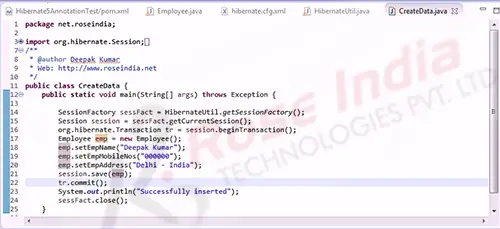
- #HIBERNATE ANNOTATIONS EXAMPLE MKYONG HOW TO#
- #HIBERNATE ANNOTATIONS EXAMPLE MKYONG INSTALL#
- #HIBERNATE ANNOTATIONS EXAMPLE MKYONG DRIVER#
- #HIBERNATE ANNOTATIONS EXAMPLE MKYONG PASSWORD#
- #HIBERNATE ANNOTATIONS EXAMPLE MKYONG DOWNLOAD#
#HIBERNATE ANNOTATIONS EXAMPLE MKYONG DOWNLOAD#
Then it gets the CustomerService bean and invoke its test() method.Run this program as a normal Java application and observe the result.For your reference, the project structure looks like this: And you can also download the sample project in the attachment section below. Public class AppConfig LocalEntityManagerFactoryBean entityManagerFactory() This program bootstraps Spring framework to scan classes in the package. Create the AppConfig class with the following code: package Configure EntityManagerFactory and TransactionManagerHere, we will use Java-based configuration with annotations for a simple Spring application. Note that the name of the persistence-unit element will be used later in the code.ģ.
#HIBERNATE ANNOTATIONS EXAMPLE MKYONG PASSWORD#
Modify the JDBC URL, user and password accordingly with your MySQL server. Configure Database Connection Properties in persistence.xmlSince Hibernate is used as the provider of JPA (Java Persistence API), we need to specify the database connection properties in the persistence.xml file which is created under the META-INF directory which is under the src/main/resources directory.Here's the content of the persistence.xml file: Save the pom.xml file, and Maven will automatically download all the required JAR files.Ģ.
#HIBERNATE ANNOTATIONS EXAMPLE MKYONG DRIVER#
And for Hibernate framework, we use only its core ORM - so add the following dependency information: Īnd the last dependency we need is JDBC driver for MySQL: Since we use the core of Spring framework with support for Spring Data JPA, add the following XML: Īs you can see, we use Spring 5. Configure Dependencies in MavenOpen the pom.xmlfile of the project to specify the required dependencies inside the section. ) ENGINE=InnoDB AUTO_INCREMENT=7 DEFAULT CHARSET=utf8 And let create a simple Maven project in Eclipse.
#HIBERNATE ANNOTATIONS EXAMPLE MKYONG HOW TO#
Just plain Spring way to keep things as simple as possible.By completing this tutorial, you will be able to understand how to configure a Spring application to use Spring Data JPA, and how simple it is in writing code for manipulating data with Spring Data JPA.In the sample project below, we will be using Java 8, Eclipse IDE, Hibernate ORM, Spring framework with Spring Data JPA, MySQL database, MySQL Connector Java as JDBC driver.Suppose that our Java application needs to manage data of the following table: You can use the following MySQL script to create this table: CREATE TABLE `customer` ( No heavy-weight XML or magic Spring Boot stuffs.

Spring in action will be a good reference to keep on your desk but will take a few weeks to digest as you learn.In this tutorial, you will learn how to get started with Spring Data JPA step-by-step through a very simple example. If you don't understand this how, you will after the hibernate/spring tutorials. use spring DI by implementing interfaces and wiring implementations at runtime for you actions/controller. I actually recommend struts2 but it won't matter much. Apache Struts 2, another popular Java Model-View-Contraller (MVC) framework, combine of both successful WebWork and Struts 1.x web frameworks. Next check hibernate annotations and annotation driven transactions:įinally, you can learn your mvc framework of choice. Take special note of layering of the bo/dao pattern and how you use interfaces but wire in implementations with spring di - this is crucial for writing quality code hibernate-one-to-many-annotation-example classtext-blue-600 titleHibernate one to many annotation example>Hibernate, annotations., job2 i need to create. Hibernate: How to use cascade in annotation - Stack Overflow Deleting Data in Spring Boot with JPA and Hibernate - HelloKoding Cascade example (save, update. Then learn how to use spring for dependency injection with maven/hibernate and xml: The Table annotation is used to specify that instances of the class should be stored in a database table named employees.It should be placed on the entity class declaration.



If I was going to recommend HOW to learn these technologies, I would say learn how to build a hibernate/maven/xml project first by following this:
#HIBERNATE ANNOTATIONS EXAMPLE MKYONG INSTALL#
ie)Īppfuse-modular-spring If you install m2e (maven 2 eclipse plugin) creating a new maven project will allow you to select the archetype. Using maven modules is a better practice. Appfuse has a Maven archetype for this stack.Īlternatively the book Spring in Action was a great resource for me in learning spring and hibernate/spring interaction - use Annotation driven transaction management as well and you have a really great start.Īppfuse-basic-spring is the basic project archetype.


 0 kommentar(er)
0 kommentar(er)
